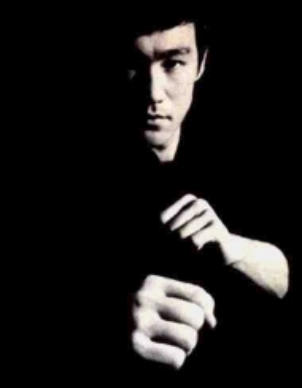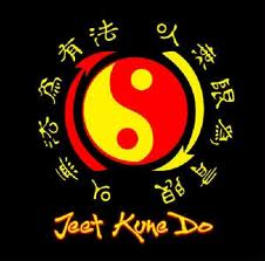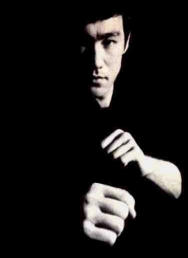
© Absolute Defense Solutions 2002

Jeet


Jeet Kune Do: is the core of our martial arts
philosophy that we teach in Tucson and is
the scientific art of street fighting developed
by Bruce Lee. Lee developed a way of self
defense to end a fight that was simple, direct,
and economical.

Our goal in JKD is to help the average
person develop skills to:
•
Win and survive a real, no-rules
street fight.
•
Prepare for virtually any and every
type of violent situation
•
Overcome a much bigger, stronger
and more dangerous opponent.
MENUM
(520) 954-0951
Golf Links and Houghton Rd
Tucson, Az 85730


HIGHER EDUCATION IN REALITY BASED SELF DEFENSE
ABSOLUTE DEFENSE SOLUTIONS offers higher level education in self defense and street
survival. Located in Tucson AZ, we provide a safe comfortable and friendly environment
to learn martial arts. We teach reality, not theory.
The Martial Art methods and techniques originally developed by Bruce Lee. Jeet
Kune Do translated as "Way of the Intercepting Fist" incorporates 4 ranges of
defense: Kicking, Punching, Trapping Hands, and Joint Locking/Grappling.
Bruce Lee researched and experimented with methods from many systems of
martial arts, using the essence of these arts in their given ranges. The methods
had to be practical and economical, with no wasted motion. The main arts he
drew from are : Wing Chun, Western Boxing, Fencing, Savate, and Jujitsu. Jeet
Kune Do practitioners train in an realistic self defense environment that helps
develop spontaneous and deceptive combat skills with an emphasis on
adaptability. It is a continuum of perpetual motion, yet there is a flow of stillness
that encapsulates awareness perceptiveness, and intuition making them among
the most skilled self defense practitioners in the world.
The Jeet Kune Do classes are a unique blend of various Martial Arts methods as
taught and developed by Bruce Lee. These training methods involve learning how
to effectively and efficiently kick, punch, trap, wrestle, sweep, throw, choke and
lock. When combined, these training methods will give the student the ability to
adapt to any self defense situation on the street. The first aspect of training
focuses on physical fitness and self-preservation (the ability to defend yourself).
The second aspect of training focuses on self-perfection (the ability to find your
own unique path). During classes, students not only practice technique and
perform dynamic drills, but they also spar and study tactics and strategy. If you
are looking for a realistic approach to self defense, this is the class for you!


"Use only that which works,
and take it from any place
you find it."
Our goal in JKD is to help the average person:
Win and survive a real, no-rules street fight
Prepare for virtually any and every type of violent situation
Overcome a much bigger, stronger and more dangerous
opponent.



We teach authentic JKD and incorporate the
original lesson plans written by Bruce Lee.

“ To me ultimately martial arts
means honestly ecpressing
yourself”
- Guiding Principles -
Jeet Kune Do is a unique martial Art system that distinguishes itself from other styles,
because it represents the quest to develop what are called physical attributes. These
attributes are physical capabilities that comprise different strengths and tolerances in an
individuals ability to use self-defense; and these ultimately define the truth in combat.
What is unique in Jeet Kune Do is that anyone can develop their specific physical abilities
and modify this system to suit what is necessary. Listed are some constructive JKD
principles noted here, with a description:

Strong
Side
Forward
-
Our
strongest
and
most
coordinated
weapons
are
used
out
in
front
(Hand
and
Foot)
where
they
can
facilitate
the
most
damage.
A
right
handed
person
will
assume
the
right
lead
fighting
stance,
while
a
left
handed
person
will
execute
the
left
lead.
The
right
lead
hand
is
used
in
80%
offense
and
20%
in
defense.
The
rear
hand
is
used
80%
as
a
defensive
tool,
and
20%
as an offensive one.
Longest
Weapon
to
the
Closest
Target
-
JKD
uses
the
lead
hand
for
punching
and
the
lead
leg
for
kicking
when
attacking
from
a
distance
to
the
nearest
target.
The
rear
tools
take
longer
to
get
to
the
target
because
their
proximity
being
somewhat
further
away
and
can
be
effectively
countered.
Non
Classical
Movement
-
We
execute
drills
that
operate
the
essence
of
aliveness
and
fluid
mobility
between
opponents
and
these
types
of
drills
realistically
represent
true
fighting
in
its
core.
We
avoid
the
use
of
forms
or
fixed
training
patterns,
because
they
cannot
truthfully
represent
the
realistic components that are a necessity, in the combative street--- defense situation.
Use
of
Broken
Rhythm
-
The
use
of
broken
rhythm
can
be
established
in
several
methods
once
a
particular
series
of
rhythm
moments
has
been
initiated.
Broken
rhythm
is
part
of
what
is
called
counter
attacking
and,
allows
you
to
catch
your
opponent
while
they
are
in
a
fixed
motion
set.
During
an
attack
there
are
several
ways
to
break
a
rhythm
within
a
series
of
movements
after
the
rhythm
has
been
established.
An
example
of
this
is
to
speed
up
suddenly,
slow
down
suddenly,
or
insert
a
brief
delay,
to
actively--
create
a
pause
in
the
sequence
of
movements.
In
counter
attacking,
a
hit
can
be
inserted
on
the
half
beat
to
break
an
opponent’s
rhythm
and
interrupt
their
attack.
If
you
hit
the
opponent
before
they
complete
the
first
strike,
you’ve
now
hit
on
the
half
beat.
If
you
carry
out
the
first
strike
with
a
parry,
and
hit
between
the
first
and
second
strikes,
it
is
clear
that
you
have
broken
the
rhythm
on
the
one
and
a
half
beat.
The
main
objective
is
controlling
the
rhythm in order to control the
fight!
Adaptability
-
The
prime
objective
here
is
to
be
free
of
fixed
techniques
or
a
single
system
method.
Fights
are
unpredictable
and
abstract
in
their
ability
to
change
instantaneously.
In
so
mastering
the
art
of
adaptability
is
king.
The
Jeet
Kune
Do
system
is
all
about
developing
mastery
of its complete totality and; this unequivocally allows self-expression, freely without limitation.
Use
of
Feints
and
False
Attacks
-
Feints
are
tricks
used
to
fool
the
opponent
and
cause
an
opponent
to
think
an
attack
is
being
launched
against
them.
False
attacks
are
obviously
intended
to
fall
short
of
a
target
and
draw
a
defensive
reaction
from
the
opponent.
The
objective
is
diversion
from
the
intention
of
your
final,
directed
point
of
attack.
Feint
training
facilitates
the
ability
to
discover
how
your
opponents
will
respond
to
your
movements
and
is
set
up
for
various
types
of
attacks, such as: Attack by Combination, Progressive, and Indirect Attack.
Interception
-
In
Jeet
Kune
Do
it
literally
means
Way
of
the
Intercepting
Fist,
it
is
least
effective
to
block
first,
and
then
hit.
The
necessity
is
to
intercept
the
attack
through---
simultaneously
parrying
and
hitting
at
the
same
time.
The
most
progressive
execution
of
this
action
is
always
developing
control
over
distance,
so
that
your
opponent
has
to
move
towards
you
to
try
to
get
to
you. There is a mind set in self-defense to hit and must be changed to think hit
Centerline
-
Occupying
centerline
is
the
equivalent
in
controlling
the
balance,
position
and
leverage
of
an
opponent
and
their
ability
to
fight
you.
Looping
or
grand
movements
signify
telegraphic
actions
which
are
easy
to
defend
or
intercept.
There
are
major
targets
stemming
down
from
centerline
such
as:
eyes,
nose,
throat,
chin,
solar
plexus
and
groin.
Strikes
going
down
centerline
are
difficult
to
see
and
defend
against,
so
with
centerline;
controlling
leverage
is
strategic, in developing control over your opponent.
Alive
Footwork
-
The
real
essence
of
good
mobility
is
in
mastering
good
footwork.
Deliberate
skilled
footwork
bridges
the
gap
between
opponents
instantaneously
because
it
is
the
dance
which
signifies
closing
the
distance.
The
executing
point
of
distance,
rhythm,
and
timing
are
controlled
with
perfection
of
fluid
footwork.
This
ideology
is
an
imperative
characteristic
of
having
pure
aliveness, the truth of core combative movement.
Focus
on
Low
Line
Kicking
-
Low
line
kicks
to
the
groin,
knee
and
shin
are
considerably
more
effective
plus
safer
to
execute.
The
point
of
high
kicking
can
result
in
danger
because;
if
a
high
kick
misses
the
opponent,
the
individual
administering
it,
will
possibly
hit
the
ground.
They
may
suddenly
find
that
they
are
in
a
vulnerable
position,
open
for
a
more
viscous
attack
from
their
opponent.
High
kicks
are
slower,
easier
to
defend,
more
telegraphic
in
nature
and
if
you
are
going
to
execute
them,
lightning
speed
is
mandatory.
Low
line
kicking
is
much
harder
to
defend,
mainly
because
it
is
much
less
telegraphic
and
the
real
necessity
of
having
balance
is
much
less
compromised.
The
Five
Ways
of
Attack
-
In
JKD
there
are
basically
five
methods
of
attack
or
point
of
attack,
they are classified in this order:
1.
Single
Direct
Attack/Single
Angulated
Attack
-
The
SDA
directly
targets
the
most
economical
route,
SDA
is
a
single
motion
(Punch
or
Kick)
which
moves
with
no
effort
to
conceal
it.
This
single
motion
punch
starts
at
the
stomach
(midline)
and
ends
on
the
chin(high
line).In
creating
an
open
line
upon
which
to
strike,
the
single
angulated
strike
is
launched
from
an
unanticipated angle that is achieved by moving to create an fully open line to-- fire a strike.
2).
Attack
by
Combination
-
This
attack
can
be
comprised
of
hand
to
hand,
hand
to
foot,
foot
to
hand
and
foot
to
foot
strikes.
Offensive
attacks
are
made
up
of
two
or
more
movements
in
a
natural progression that lands on single or multiple targets.
3).
Attack
by
Draw
-
Baiting
the
opponent
is
what
looks
like
an
exposed
target,
then
intercepting
their
motion.
The
objective
is
clearly
to
draw
the
opponent
into
a
committed
attack
by
suckering
them
into
what
looks
like
an
exposed
target,
followed
by
the
point
of
interception.
It
is
possible
to
administer
a
motion
that
invites
a
counter,
and
then
counter
attack
them
as
they
are
suckered
to
take the bait.
4).
Progressive
Indirect
Attack
-
This
timing
is
used
to
take
advantage
of
the
best
window
of
opportunity
to
deceive
the
opponent.
Taken
from
Western
Fencing
originally,
the
idea
of
second
intention
is
used
here
where
an
initial
false
attack
or
feint
is
launched--
to
draw
a
type
of
defensive
response
from
your
opponent.
Once
you
receive
the
attempted
block
or
parry,
it
is
imperative
to
deceive
the
defensive
motion
by
quickly
shifting
lines
and
hitting
to
an
open
target.
Progressive
attack
means
covering
at
least
half
the
distance
between
you
and
your
opponent
by
moving
forward
on
the
initiated
false
attack
or
feint.
The
indirect
attack
equals
gaining
time
by
directing
your
opponent
a
half
beat
behind
your
motions.
It
is
strategic
to
shift
lines
just
as
its
moving
towards you, instead of anticipating their block to land a hit.
5).
Hand
Immobilization
Attack
-
The
focus
of
this
attack
will
be
to
momentarily
immobilize
or
trap
one
or
both
of
the
opponents
arms,
allowing
a
direct
route
or
strike
into
an
open
line.
The
hand
immobilization
attack
was
an
original
tool
taken
from
Wing
Chun
and
later
modified.
The
art
of
trapping
is
primarily
strategic
because
of
its
effectiveness
against
systems
that
block
first
and
then
hit.
The
objective
is
to
purposely
draw
a
reaction
from
an
opponent,
and
counter
with
a
directly executed trap.
Non
Telegraphic
Movement
-
The
essence
of
this
movement
is
to
punch
and
kick
efficiently
without
telegraphing
our
intentions.
Before
striking,
kicking,
punching,
or
stepping
in,
there
is
a
building
sequence
or
a
movement
which
signals
to
the
opponent
what
you’re
about
to
present.
This
gives
the
opponent
the
opportunity
to
read
your
intent
and
counter
attack
you.
JKD
effectively
teaches the intent of the sucker punch or kick, without telegraphing our main intentions.
(520) 954-0951
Golf Links and Houghton Rd, Tucson, Az 85730
Email: TuckerDefense@yahoo.com














